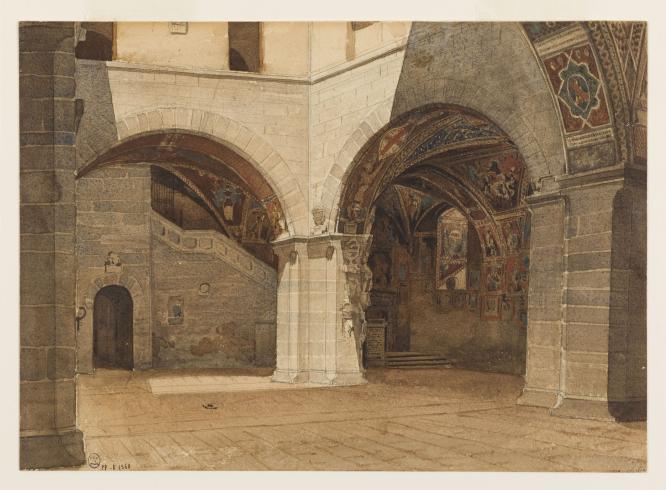Charles Garnier was awarded the Grand Prix d’architecture (architecture bursary prize to Rome) in 1848 at the age of 22 with a plan for an arts and crafts conservatoire incorporating an exhibition gallery for the products of industry.
As soon as he arrived at the Villa, he composed songs, slipping requests into his verses for a rug or armchair for lodgers’ bedrooms. The young artist also dashed off comic sketches which were performed at the salons of the director, Alaux. Garnier made numerous trips in the course of which he painted watercolours of palaces and churches like these two watercolours, which show a clear attraction towards the colours of frescos, emphasising architecture and illuminating perspective.
The choice of the Bargello Palace may have been inspired by the discovery in 1840 of a portrait of Dante by Giotto which led to the restoration of the palace and its eventual transformation into a museum in 1859. Similar watercolours depicting views of Venice or the Church of St Clement in Rome preserved at the Paris School of Fine Art and the Louvre demonstrate the young architect’s genuine skill as a painter.
His quest for polychromy and his taste for architecture encouraged him to travel to Greece in 1852 with Théophile Gautier, the painter, Alfred de Curzon and the art critic Edmond About. The Parthenon provided a spur to his vocation: “there is no question of choice between the arts, you have to be God or an architect”. On the island of Aegina, he studied the temple of Aphaia. Discovering some red and blue on a metope, he came down decisively in favour of the theory of polychromy in the architecture of ancient temples and presented his work at the Salon of 1853.
In 1860, he was selected to build the Paris Opera House. Empress Eugenie expressed her surprise: “What on earth is this style? ... This is not a style! ... It is neither Greek nor Louis XVI, nor even Louis XV...!" The young, unknown Charles Garnier replied: “No, those styles have had their day... It’s the Napoleon III style! And yet still you complain!” As he had observed in Italy, the arts yield and become part of the architecture which encompasses them.
C. V. de J.

City of Paris municipal collection's website
The collections portal can be used to search the collections of Paris’s 14 municipal museums (approximately 336,000 works, including 43,000 belonging to the Petit Palais).
It is also possible to download around 12,000 images of the museum’s works free of charge.
Access the Museums of the City of Paris collections portal
Extern databases
Discover a selection of databases online presenting works from the Petit Palais or documents concerning the history of the museum.

